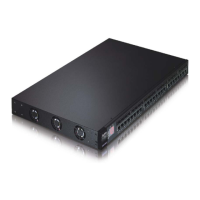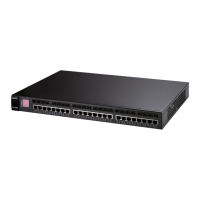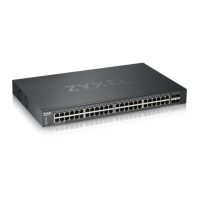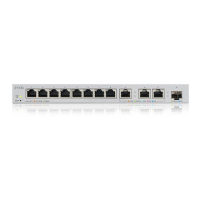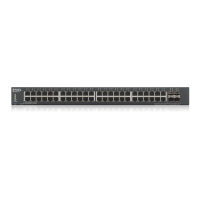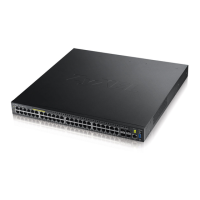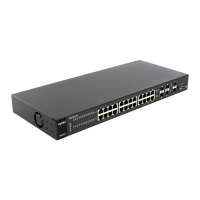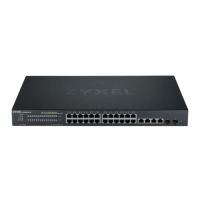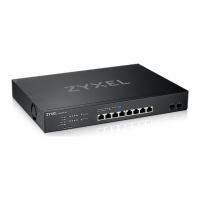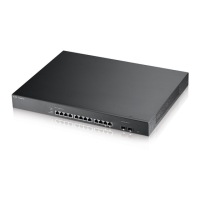
Do you have a question about the ZyXEL Communications XGS2210-52 and is the answer not in the manual?
| Brand | ZyXEL Communications |
|---|---|
| Model | XGS2210-52 |
| Category | Switch |
| Language | English |
Guides users on how to start the web browser, access the switch IP address, and log in with default credentials.
Recommends changing the default administrator password for enhanced security and provides steps to do so.
Explains how to save configuration changes to run-time memory and non-volatile memory using Apply and Save links.
Explains how to reload the factory-default configuration file or reset the switch to factory defaults if locked out.
Shows how to configure a different management IP address in a different subnet for management purposes, illustrating an example.
Provides a tutorial on configuring DHCPv4 snooping, including VLAN creation and port trusted states.
Guides users on configuring the switch to forward DHCP client requests to a specific DHCP server, including VLAN setup.
Explains configuring the Switch IP address, default gateway, and management VLAN ID for network access.
Explains configuring stacking for multiple switches, managing cluster members, and viewing stacking status and slot information.
Explains how to configure static VLANs for the switch, including setting port VLAN IDs and controlling frame tagging.
Explains setting up static MAC address rules for ports, which can enhance security by limiting access to known MAC addresses.
Details how to create rules for traffic filtering based on MAC addresses, VLAN IDs, and actions like discarding source or destination.
Explains how to activate STP modes (RSTP, MRSTP, MSTP) on the switch via the Spanning Tree Configuration screen.
Details how to configure RSTP settings, including bridge priority, hello time, and port states.
Guides on configuring MRSTP settings, including bridge priority, hello time, and port configurations for each STP tree.
Explains how to configure MSTP settings, including region configuration, revision number, and instance settings.
Guides on limiting bandwidth for traffic through the switch by configuring ingress and egress rates per port.
Details how to limit broadcast, multicast, and DLF packets per second on ports by specifying limits.
Guides on selecting a monitor port and specifying traffic flow to be copied for analysis.
Guides on configuring static link aggregation and selecting traffic distribution algorithms.
Guides on activating IEEE 802.1x security, including port authentication and configuration.
Details how to activate MAC authentication, using source MAC address and password for client validation.
Guides on enabling port security and disabling MAC address learning, or enabling the feature on specific ports.
Guides on defining schedules for time-oriented features, including absolute and periodic time ranges.
Guides on defining classifiers, specifying actions (policy), and viewing configuration summaries.
Guides on configuring policy rules after defining classifiers, specifying actions like forwarding, priority, or metering.
Details setting priorities for switch queues to distribute bandwidth, configure methods (SPQ, WFQ, WRR) and weights.
Guides on configuring IGMP snooping and filtering for IPv4 multicast traffic, and managing multicast groups.
Details configuring MLD snooping-proxy and filtering for IPv6 multicast traffic, and managing MLD snooping-proxy VLAN settings.
Guides on configuring RADIUS server settings for authentication and accounting, including modes and timeouts.
Details configuring TACACS+ server settings for authentication and accounting, including modes and timeouts.
Explains how to configure authentication, authorization, and accounting methods and priorities on the switch.
Details viewing current bindings for DHCP snooping and ARP inspection, distinguishing authorized and unauthorized packets.
Explains managing static bindings by MAC address and VLAN ID for DHCP snooping and ARP inspection.
Guides on viewing DHCP snooping statistics, enabling snooping, and configuring the database and trusted ports.
Guides on enabling ARP inspection, configuring trusted/untrusted ports, and setting packet rates.
Guides on manually creating IPv6 source guard binding table entries and managing static bindings.
Explains setting policies to forward valid IPv6 addresses/prefixes and allow or block traffic from link-local addresses.
Guides on enabling loop guard on the Switch and specific ports, noting it cannot be enabled with STP active.
Guides on enabling layer 2 protocol tunneling and specifying MAC addresses for packet encapsulation.
Guides on configuring sFlow for the Switch to monitor traffic and send information to an sFlow collector.
Guides on configuring the PPPoE Intermediate Agent globally and specifying access-node identifiers and circuit/remote IDs.
Details specifying trusted/untrusted ports and adding extra information to PPPoE discovery packets on a per-port basis.
Explains configuring PPPoE IA settings that apply to a specific VLAN on a port, including Circuit ID and Remote ID.
Details limiting control packet rates on ports and configuring actions when limits are exceeded.
Explains how to detect control packet rate limits and configure actions when limits are exceeded.
Guides on configuring the switch to automatically undo actions after errors are resolved, specifying timer intervals.
Guides on enabling MAC pinning on the switch and specific ports.
Guides on configuring private VLAN rules, specifying promiscuous and isolated ports.
Details configuring EEE, Auto Power Down, and Short Reach features globally and per port for power saving.
Details configuring global LLDP settings like transmit interval, hold, delay, and admin status per port.
Details configuring LLDP-MED parameters for media endpoint devices, including network policy and location.
Guides on setting LLDP-MED network policy for applications like voice, video, and softphones.
Explains how to create or remove trusted hosts identified by IP address and subnet mask, for which Anti-arpscan is not performed.
Details enabling Anti-Arpscan, setting port and host thresholds, and configuring ports as trusted or untrusted.
Guides on turning on the BPDU guard feature on the Switch and specific ports.
Guides on enabling Ethernet OAM on the Switch and ports, and configuring mode and remote loopback settings.
Details how to perform remote-loopback tests on ports to verify link status and troubleshoot connection problems.
Guides on enabling ZULD on ports, configuring mode (Normal/Aggressive), and setting probe time.
Guides on accessing screens to create IPv4 and IPv6 static routing rules.
Details how to configure and enable IPv4 static routes, specifying destination IP address, subnet mask, and gateway.
Explains how to configure and enable IPv6 static routes, specifying destination IPv6 address, prefix length, and next hop.
Guides on activating DiffServ to apply marking rules or IEEE 802.1p priority mapping on the Switch.
Details how to configure DSCP to IEEE 802.1p mapping to prioritize traffic based on DSCP values.
Guides on configuring the switch as a DHCP relay agent, adding Relay Agent Information (Option 82) to DHCP requests.
Explains how to configure global DHCPv4 relay, specifying DHCP servers and Option 82 profiles.
Explains configuring DHCPv6 relay agents for forwarding messages between DHCPv6 servers and clients.
Guides on configuring ARP learning modes (ARP-Reply, Gratuitous-ARP, ARP-Request) for each port.
Explains how to create static ARP entries in the ARP table that will not age out.
Guides on removing the running configuration and clearing all configured information, without resetting factory defaults.
Explains how to save current configuration settings to Configuration 1, Configuration 2, or a custom default file.
Details restarting the switch and loading various configurations (Config 1, Config 2, Stacking, Custom, Factory Default).
Guides on upgrading the switch firmware using the Firmware Upgrade screen, specifying firmware images and loading.
Explains how to restore a previously saved configuration file from a computer to the switch.
Details saving and storing current device settings to create configuration snapshots for later restoration.
Details configuring SNMP settings, including version, community strings, and trap destinations.
Guides on creating SNMP users for authentication with managers using SNMP v3 and associating them to SNMP groups.
Details managing login accounts (administrator and non-administrators), including setting usernames, passwords, and privilege levels.
Explains deciding what services (Telnet, SSH, FTP, HTTP, HTTPS, ICMP, SNMP) may be used to access the switch.
Guides on specifying trusted computers for managing the switch via various services.
Guides on using the Diagnostic screen to ping IP addresses, run traceroute, perform port tests, and show switch location.
Guides on checking current system logs, refreshing, clearing, and downloading logs.
Guides on configuring system logging settings and setting up a list of external syslog servers.
Guides on configuring clustering management, including setting up the cluster manager and adding cluster members.
Guides on checking MAC address status (dynamic or static) and sorting data by IP address, VLAN, or port.
Guides on viewing IP address information, sorting data by IP, VLAN, or port, and checking IP address type (dynamic/static).
Addresses common login problems like forgetting IP addresses or passwords, and accessing the web configurator.

